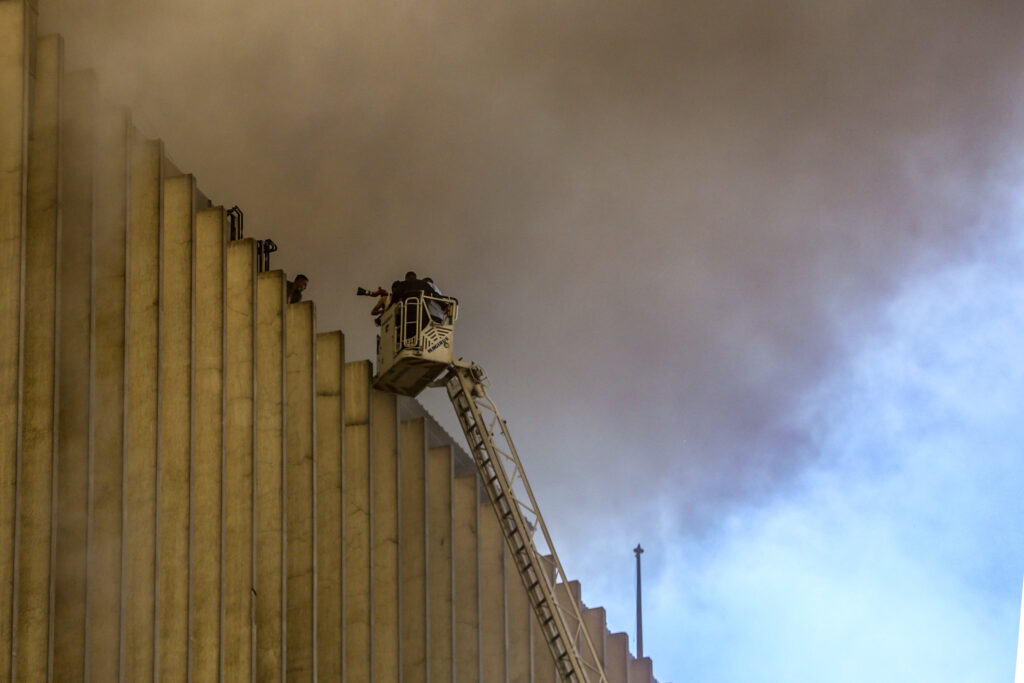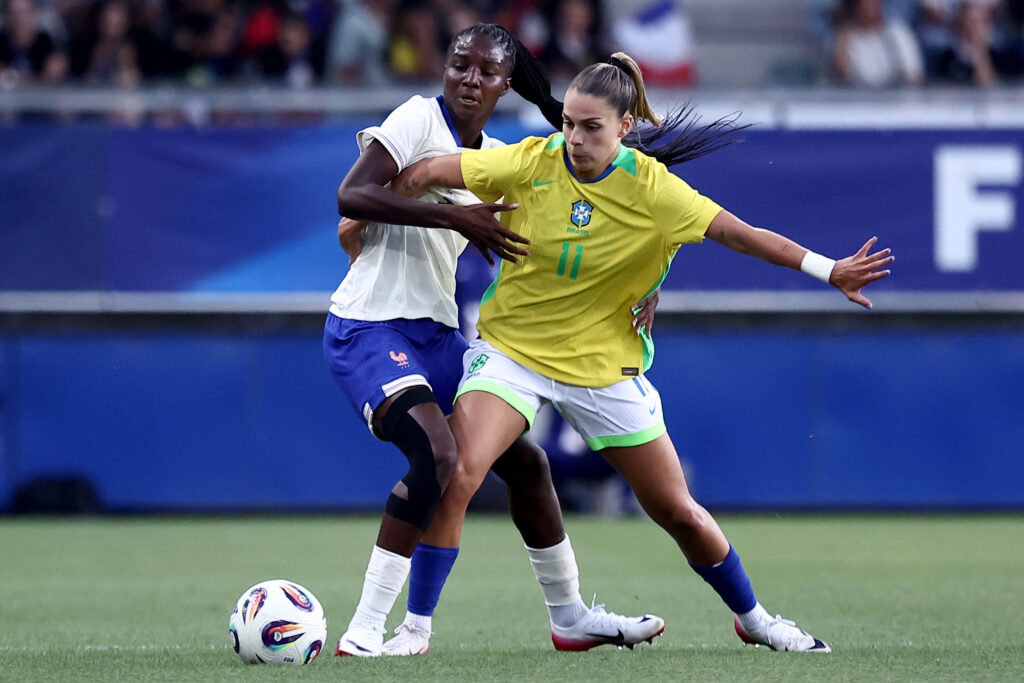Four dead in fire at major Cairo telecomms hub, internet disrupted
At least four people were killed and 27 injured in a fire at a major telecomms centre in Egypt’s capital that caused widespread disruptions, the health ministry said on Tuesday.Internet and phone connections were still heavily disrupted in Cairo on Tuesday, with the Egyptian stock exchange suspending operations.Flights into and out of the capital had also been affected by the fire, which began on Monday evening, although by the following morning the civil aviation ministry said all flights had resumed following delays caused by the blaze.Gas and electricity outages were also reported on Monday by Cairo governor Ibrahim Saber.”Civil defence forces recovered four bodies from the scene of the incident,” the healthy ministry said in a statement.The authorities are yet to announce a cause for the fire, nor has any information been given about the 27 injured. Local media reported that the fire at the Ramses Exchange, the former communications ministry headquarters, was extinguished on Monday night.
Le vaste incendie de Narbonne renforcé par la météo, “après-midi difficile” prévoient les pompiers
Un vent à 75 km/h, une chaleur qui monte tandis que l’humidité faiblit, les conditions météo renforcent mardi à la mi-journée l’incendie qui ravage les abords de Narbonne depuis la veille, et présagent d’heures à venir compliquées, selon le chef des pompiers.”On sait qu’on va avoir une après-midi difficile avec des pompiers éprouvés” par le travail de la nuit, estime le colonel Christophe Magny, commandant du Service départemental d’incendie et de secours (SDIS) de l’Aude, pointant un “risque de propagation élevé”.Pour éviter les stationnements anarchiques de nombreux camions et fluidifier le trafic routier en cette période de congés estival, l’autoroute A9, fermée depuis lundi après-midi, causant des dizaines de kilomètres d’embouteillages a été rouverte à la circulation en fin de matinée sur cet axe très emprunté.Depuis lundi 14h45, les pompiers – désormais plus d’un millier venus de toute la France, avec un renfort de quelques pompiers roumains – luttent contre un incendie qui a parcouru 2.000 hectares de forêt, à proximité directe de Narbonne et des communes environnantes, tentant de traiter “plus de 25 km de lisières” pour le contenir.Mardi dans la matinée, le paysage de Prat-de-Cets est noirci, quand les arbres ne sont pas encore en flammes: le hameau de la commune de Bages, près de Narbonne, s’est trouvé sur le passage des flammes.Le crépitement de la végétation qui continue de brûler est couvert de temps à autre par le va-et-vient des camions de pompiers, applaudis par Martine Bou, les larmes aux yeux face au sinistre.Cette retraitée assure à l’AFP avoir vu les flammes s’approcher jusqu’à une vingtaine de mètres de sa maison. “On était tous dehors, tous au bord de la route, à surveiller. Et puis, ça s’est avancé, ça s’est avancé…”, raconte-t-elle au petit matin.Ensuite, le maire est arrivé, disant “qu’il fallait tout fermer”, alors elle a “commencé à sortir les caisses pour (s)es chats, récupérer (s)es tortues, mettre le chien dans la voiture”, avant d’évacuer vers Peyriac-de-Mer et de revenir au matin. Elle s’interrompt, la gorge bloquée par un sanglot.- “toujours pas maîtrisé” -Plus d’un millier de pompiers ont lutté toute la nuit contre les flammes et cinq d’entre eux ont été “très légèrement blessés”, indique dans un communiqué publié tôt mardi matin la préfecture de l’Aude, département déjà touché par trois feux de forêt en une semaine. Ils espèrent “fixer” le feu d’ici à la fin de la journée.”L’incendie n’est toujours pas maîtrisé. C’est un incendie qui a progressé très vite, compte tenu du vent. Six maisons ont été partiellement touchées. Le feu est allé jusqu’à l’étang de Bages, aux portes du village. L’avant du feu ne progresse plus et il faut traiter les flancs, et veiller à ce qu’il ne s’élargisse pas”, a détaillé à l’AFP le préfet de l’Aude Christian Pouget.Les autorités maintiennent leur appel au confinement appliqué à plusieurs quartiers du sud de la ville de Narbonne, des villages de Bages et de Peyriac-de-Mer.Le mari de Martine Bou, Frédéric, “n’a jamais vu ça”, “des flammes de 50 ou 60 m de hauteur, facile.”- Risque toujours élevé -Depuis lundi, une forte tramontane, soufflant du nord-ouest vers le sud-est, attise le feu, “le vent va reprendre, ça va être compliqué dans l’après-midi”, anticipe également le préfet de l’Aude.Lundi, les avions bombardiers d’eau et de produits retardants se sont relayés au-dessus du brasier jusqu’à la tombée de la nuit. Une reprise des rotations des moyens aériens était attendue mardi après-midi.Le feu, parti lundi dans des circonstances inconnues, d’un domaine viticole dans le massif des Corbières, s’est vite propagé, avec des rafales soufflant à 90 km/h.La végétation desséchée par un fort déficit pluviométrique atteignant 69% en juin, plus la période de canicule prolongée ces derniers jours, forme un cocktail incendiaire redoutable, selon un prévisionniste de Météo-France, Adrien Warnan.Une enquête a été ouverte par le parquet de Narbonne pour déterminer les causes de l’incendie.Dans la nuit de lundi à mardi, de nombreux automobilistes et chauffeurs de poids lourds surpris par l’incendie ont dormi dans leur véhicule. Environ 500 personnes ont été hébergées au parc des expositions de Narbonne, dans des salles communales ou gymnases à Sigean, Ferrals-des-Corbières ou Portel-des-Corbières.L’Aude a connu trois incendies en une semaine. Le 29 juin, un feu a consumé 400 hectares sur la commune voisine de Bizanet, déclenché par le passage du véhicule d’un traiteur transportant sur sa remorque un barbecue mal éteint.Le week-end dernier, un nouvel incendie a parcouru 430 hectares à proximité du village de Douzens, parti d’une voiture ayant pris feu sur la bande d’arrêt d’urgence de l’A61 Toulouse-Narbonne.
Le vaste incendie de Narbonne renforcé par la météo, “après-midi difficile” prévoient les pompiers
Un vent à 75 km/h, une chaleur qui monte tandis que l’humidité faiblit, les conditions météo renforcent mardi à la mi-journée l’incendie qui ravage les abords de Narbonne depuis la veille, et présagent d’heures à venir compliquées, selon le chef des pompiers.”On sait qu’on va avoir une après-midi difficile avec des pompiers éprouvés” par le travail de la nuit, estime le colonel Christophe Magny, commandant du Service départemental d’incendie et de secours (SDIS) de l’Aude, pointant un “risque de propagation élevé”.Pour éviter les stationnements anarchiques de nombreux camions et fluidifier le trafic routier en cette période de congés estival, l’autoroute A9, fermée depuis lundi après-midi, causant des dizaines de kilomètres d’embouteillages a été rouverte à la circulation en fin de matinée sur cet axe très emprunté.Depuis lundi 14h45, les pompiers – désormais plus d’un millier venus de toute la France, avec un renfort de quelques pompiers roumains – luttent contre un incendie qui a parcouru 2.000 hectares de forêt, à proximité directe de Narbonne et des communes environnantes, tentant de traiter “plus de 25 km de lisières” pour le contenir.Mardi dans la matinée, le paysage de Prat-de-Cets est noirci, quand les arbres ne sont pas encore en flammes: le hameau de la commune de Bages, près de Narbonne, s’est trouvé sur le passage des flammes.Le crépitement de la végétation qui continue de brûler est couvert de temps à autre par le va-et-vient des camions de pompiers, applaudis par Martine Bou, les larmes aux yeux face au sinistre.Cette retraitée assure à l’AFP avoir vu les flammes s’approcher jusqu’à une vingtaine de mètres de sa maison. “On était tous dehors, tous au bord de la route, à surveiller. Et puis, ça s’est avancé, ça s’est avancé…”, raconte-t-elle au petit matin.Ensuite, le maire est arrivé, disant “qu’il fallait tout fermer”, alors elle a “commencé à sortir les caisses pour (s)es chats, récupérer (s)es tortues, mettre le chien dans la voiture”, avant d’évacuer vers Peyriac-de-Mer et de revenir au matin. Elle s’interrompt, la gorge bloquée par un sanglot.- “toujours pas maîtrisé” -Plus d’un millier de pompiers ont lutté toute la nuit contre les flammes et cinq d’entre eux ont été “très légèrement blessés”, indique dans un communiqué publié tôt mardi matin la préfecture de l’Aude, département déjà touché par trois feux de forêt en une semaine. Ils espèrent “fixer” le feu d’ici à la fin de la journée.”L’incendie n’est toujours pas maîtrisé. C’est un incendie qui a progressé très vite, compte tenu du vent. Six maisons ont été partiellement touchées. Le feu est allé jusqu’à l’étang de Bages, aux portes du village. L’avant du feu ne progresse plus et il faut traiter les flancs, et veiller à ce qu’il ne s’élargisse pas”, a détaillé à l’AFP le préfet de l’Aude Christian Pouget.Les autorités maintiennent leur appel au confinement appliqué à plusieurs quartiers du sud de la ville de Narbonne, des villages de Bages et de Peyriac-de-Mer.Le mari de Martine Bou, Frédéric, “n’a jamais vu ça”, “des flammes de 50 ou 60 m de hauteur, facile.”- Risque toujours élevé -Depuis lundi, une forte tramontane, soufflant du nord-ouest vers le sud-est, attise le feu, “le vent va reprendre, ça va être compliqué dans l’après-midi”, anticipe également le préfet de l’Aude.Lundi, les avions bombardiers d’eau et de produits retardants se sont relayés au-dessus du brasier jusqu’à la tombée de la nuit. Une reprise des rotations des moyens aériens était attendue mardi après-midi.Le feu, parti lundi dans des circonstances inconnues, d’un domaine viticole dans le massif des Corbières, s’est vite propagé, avec des rafales soufflant à 90 km/h.La végétation desséchée par un fort déficit pluviométrique atteignant 69% en juin, plus la période de canicule prolongée ces derniers jours, forme un cocktail incendiaire redoutable, selon un prévisionniste de Météo-France, Adrien Warnan.Une enquête a été ouverte par le parquet de Narbonne pour déterminer les causes de l’incendie.Dans la nuit de lundi à mardi, de nombreux automobilistes et chauffeurs de poids lourds surpris par l’incendie ont dormi dans leur véhicule. Environ 500 personnes ont été hébergées au parc des expositions de Narbonne, dans des salles communales ou gymnases à Sigean, Ferrals-des-Corbières ou Portel-des-Corbières.L’Aude a connu trois incendies en une semaine. Le 29 juin, un feu a consumé 400 hectares sur la commune voisine de Bizanet, déclenché par le passage du véhicule d’un traiteur transportant sur sa remorque un barbecue mal éteint.Le week-end dernier, un nouvel incendie a parcouru 430 hectares à proximité du village de Douzens, parti d’une voiture ayant pris feu sur la bande d’arrêt d’urgence de l’A61 Toulouse-Narbonne.
Le vaste incendie de Narbonne renforcé par la météo, “après-midi difficile” prévoient les pompiers
Un vent à 75 km/h, une chaleur qui monte tandis que l’humidité faiblit, les conditions météo renforcent mardi à la mi-journée l’incendie qui ravage les abords de Narbonne depuis la veille, et présagent d’heures à venir compliquées, selon le chef des pompiers.”On sait qu’on va avoir une après-midi difficile avec des pompiers éprouvés” par le travail de la nuit, estime le colonel Christophe Magny, commandant du Service départemental d’incendie et de secours (SDIS) de l’Aude, pointant un “risque de propagation élevé”.Pour éviter les stationnements anarchiques de nombreux camions et fluidifier le trafic routier en cette période de congés estival, l’autoroute A9, fermée depuis lundi après-midi, causant des dizaines de kilomètres d’embouteillages a été rouverte à la circulation en fin de matinée sur cet axe très emprunté.Depuis lundi 14h45, les pompiers – désormais plus d’un millier venus de toute la France, avec un renfort de quelques pompiers roumains – luttent contre un incendie qui a parcouru 2.000 hectares de forêt, à proximité directe de Narbonne et des communes environnantes, tentant de traiter “plus de 25 km de lisières” pour le contenir.Mardi dans la matinée, le paysage de Prat-de-Cets est noirci, quand les arbres ne sont pas encore en flammes: le hameau de la commune de Bages, près de Narbonne, s’est trouvé sur le passage des flammes.Le crépitement de la végétation qui continue de brûler est couvert de temps à autre par le va-et-vient des camions de pompiers, applaudis par Martine Bou, les larmes aux yeux face au sinistre.Cette retraitée assure à l’AFP avoir vu les flammes s’approcher jusqu’à une vingtaine de mètres de sa maison. “On était tous dehors, tous au bord de la route, à surveiller. Et puis, ça s’est avancé, ça s’est avancé…”, raconte-t-elle au petit matin.Ensuite, le maire est arrivé, disant “qu’il fallait tout fermer”, alors elle a “commencé à sortir les caisses pour (s)es chats, récupérer (s)es tortues, mettre le chien dans la voiture”, avant d’évacuer vers Peyriac-de-Mer et de revenir au matin. Elle s’interrompt, la gorge bloquée par un sanglot.- “toujours pas maîtrisé” -Plus d’un millier de pompiers ont lutté toute la nuit contre les flammes et cinq d’entre eux ont été “très légèrement blessés”, indique dans un communiqué publié tôt mardi matin la préfecture de l’Aude, département déjà touché par trois feux de forêt en une semaine. Ils espèrent “fixer” le feu d’ici à la fin de la journée.”L’incendie n’est toujours pas maîtrisé. C’est un incendie qui a progressé très vite, compte tenu du vent. Six maisons ont été partiellement touchées. Le feu est allé jusqu’à l’étang de Bages, aux portes du village. L’avant du feu ne progresse plus et il faut traiter les flancs, et veiller à ce qu’il ne s’élargisse pas”, a détaillé à l’AFP le préfet de l’Aude Christian Pouget.Les autorités maintiennent leur appel au confinement appliqué à plusieurs quartiers du sud de la ville de Narbonne, des villages de Bages et de Peyriac-de-Mer.Le mari de Martine Bou, Frédéric, “n’a jamais vu ça”, “des flammes de 50 ou 60 m de hauteur, facile.”- Risque toujours élevé -Depuis lundi, une forte tramontane, soufflant du nord-ouest vers le sud-est, attise le feu, “le vent va reprendre, ça va être compliqué dans l’après-midi”, anticipe également le préfet de l’Aude.Lundi, les avions bombardiers d’eau et de produits retardants se sont relayés au-dessus du brasier jusqu’à la tombée de la nuit. Une reprise des rotations des moyens aériens était attendue mardi après-midi.Le feu, parti lundi dans des circonstances inconnues, d’un domaine viticole dans le massif des Corbières, s’est vite propagé, avec des rafales soufflant à 90 km/h.La végétation desséchée par un fort déficit pluviométrique atteignant 69% en juin, plus la période de canicule prolongée ces derniers jours, forme un cocktail incendiaire redoutable, selon un prévisionniste de Météo-France, Adrien Warnan.Une enquête a été ouverte par le parquet de Narbonne pour déterminer les causes de l’incendie.Dans la nuit de lundi à mardi, de nombreux automobilistes et chauffeurs de poids lourds surpris par l’incendie ont dormi dans leur véhicule. Environ 500 personnes ont été hébergées au parc des expositions de Narbonne, dans des salles communales ou gymnases à Sigean, Ferrals-des-Corbières ou Portel-des-Corbières.L’Aude a connu trois incendies en une semaine. Le 29 juin, un feu a consumé 400 hectares sur la commune voisine de Bizanet, déclenché par le passage du véhicule d’un traiteur transportant sur sa remorque un barbecue mal éteint.Le week-end dernier, un nouvel incendie a parcouru 430 hectares à proximité du village de Douzens, parti d’une voiture ayant pris feu sur la bande d’arrêt d’urgence de l’A61 Toulouse-Narbonne.
Euro-2025: dans la défense des Bleues, place à la jeunesse
Jouez jeunesse: pour affronter le Pays de Galles à l’Euro, le sélectionneur des Bleues Laurent Bonadei mise sur trois joueuses de 20 et 21 ans quasi novices au niveau international, Melween N’Dongala, Thiniba Samoura et Alice Sombath.En face c’est l’inverse: pour leur premier grand tournoi, les Galloises s’appuient sur un quatuor de joueuses à plus de 100 sélections. Pour ce second match du tournoi continental, le moins difficile de la poule, Laurent Bonadei avait prévenu avant le choc contre l’Angleterre: “Je peux déjà vous dire que celles qui vont démarrer le match contre le Pays de Galles seront différentes”, voulant garder tout le groupe impliqué.Il le répète à l’envi: il n’y a pas d’équipe type et il veut s’appuyer sur la jeunesse, alors que son équipe a perdu en expérience avec les non sélections de Wendie Renard, Eugénie Le Sommer et Kenza Dali.”Tout le monde peut emmener tout le monde, il n’y a personne en dessous de personne. On a un collectif, on a été emmenées par les plus jeunes” samedi, a abondé l’attaquante vedette Marie-Antoinette Katoto.En raison de l’absence de la capitaine Griedge Mbock, touchée au mollet droit, et de sa partenaire en défense centrale Maëlle Lakrar, préservée après avoir reçu plusieurs coups contre les “Lionesses”, Bonadei devrait faire confiance à la charnière formée par Alice Sombath, déjà impressionnante samedi soir, et Thiniba Samoura, âgées toutes les deux de 21 ans. A droite, Melween N’Dongala, 20 ans, devrait connaître sa seconde titularisation. La latérale gauche Selma Bacha, 47 sélections, fera donc figure de joueuse d’expérience en défense à 24 ans.. Thiniba Samoura (PSG, 7 sélections avec les Bleues)C’est “une force tranquille et un roc”, a estimé lundi la gardienne Pauline Peyraud-Magnin. Très athlétique (1,72 m), elle est rapide et puissante. Hors des terrains, la Parisienne formée au PFC (2019-2023) avant de rejoindre le PSG, est plutôt réservée et casanière mais sait ce qu’elle veut, décrit une source proche de l’équipe de France. Deuxième d’une fratrie de quatre enfants, dont une soeur qui joue au Thiais FC (Val-de-Marne) où elle a aussi commencé à 11 ans, elle a connu une saison au PSG en demi-teinte. Dans la capitale, elle a alterné entre l’entre-jeu, la charnière centrale et le poste de latérale droite, ce qui l’a gênée dans sa progression.. Melween N’Dongala, (PFC, 4 sélections avec les Bleues)A 20 ans, elle est la benjamine du groupe. Mais quand elle est entrée samedi dans les dix dernières minutes alors que les Anglaises poussaient pour égaliser, elle a fait preuve d’une grande maturité mais aussi d’audace, à l’image d’un tacle rageur en toute fin de match pour soulager la défense. Elle “ose et n’a pas de pression sur le terrain” avec un “profil moderne comme ça se fait chez les garçons, penchée vers l’attaque” et une “très bonne qualité de passes”, détaille une source, ajoutant qu’elle “apporte une plus-value offensive redoutable”.. Alice Sombath (OL Lyonnes, 5 sélections avec les Bleues)Sa prestation contre les championnes d’Europe en titre a marqué les esprits, dans la suite logique de sa demi-finale contre Arsenal avec l’OL Lyonnes, son autre match référence qui a poussé le sélectionneur à la convoquer pour l’Euro. Numériquement, elle remplace d’ailleurs la capitaine et défenseuse emblématique Wendie Renard, dont elle est proche à Lyon.Solide et calme dans ses interventions et dans les duels contre les attaquantes anglaises, elle a “montré beaucoup de maturité malgré son jeune âge”, salue Peyraud-Magnin.La Lyonnaise a “été incroyable, c’est une fille à l’écoute, on parle beaucoup avec elle”, renchérit la milieu Sakina Karchaoui, qui avait récupéré face aux Anglaises le brassard de Mbock.”Je savais qu’il y avait des attentes autour de moi, j’ai juste donné le meilleur de moi-même”, avait commenté après la victoire Alice Sombath.”J’ai entière confiance en elles”, a lancé lundi “PPM”, pour que les Bleues abordent au mieux l’autre choc contre les Pays-Bas dimanche prochain.




